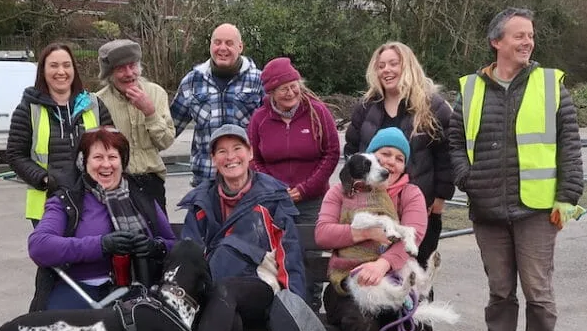Reallocating Roads

London, England - April 14, 2016: Cyclists using the newly opened segregated Cycle Superhighway at Kennington Oval in South London.
If cities belong to people, why are we building them for cars? Before the advent of the automobile, city streets were human spaces. They were thoroughfares and public places where people would meet, socialise and sell goods. Everyone was included when cars were excluded. Today, the most common perception is that our streets are the exclusive domains of motorised vehicles.
Ironically, the car is not even the most efficient form of urban transportation. Far from it, as a recent European report from the Ellen MacArthur Foundation pointed out:
A car is parked ninety-two percent of the time – often on valuable inner-city land. When the car is used, only one-and-a-half of its five seats are occupied. Less than twenty percent of the total petroleum energy is translated into kinetic energy, and only one thirteenth of that energy is used to transport people. As much as fifty percent of inner-city land is devoted to mobility (roads and parking spaces). But, even at rush hour, cars cover only ten percent of the average European road.
Car manufacturers are keen to promote more fuel-efficient engines today, more electric cars tomorrow and more autonomous vehicles in the future, as the solution to an urban challenge that is more complex and diverse than driving. It is no surprise that this is their view of the world, as they see everything from the vantage point of the driver’s seat of a car. It is also all too easy to lose our own perspective in high-octane-fuelled advertising and fantasies of open roads.
Beyond the zeitgeist of reinventing the automobile remains the more human consideration of developing modern cities as habitats for people and not cars. The suitability of cars in the evolving urban context is even more questionable as building cities around them increases congestion, encourages urban sprawl and discourages the use of public transport. What would things look like instead if we are daring enough to change our urban traffic culture fundamentally, from catering to the exclusiveness of private vehicles to embracing the inclusiveness of walking, cycling and public transport?
Take London as one example of the massive potential of this mind shift in our mobility. Last year, Londoners took a staggering total of almost twenty million trips – each day. A policy analysis report by Transport for London discovered that of these trips, thirteen million are made by motorised transport and over half of these are short enough that they could potentially be cycled instead.
The greatest potential in London for cycling comes from people who travel by car instead: for every trip made by rail or Underground that could be cycled, there are more than five made by car that could be cycled. The most significant barrier to making this change? Most trips that could be cycled would be made by people who currently do not cycle at all. Looking to the future of urban transport, the report concluded with the call to action: “We need to encourage people who don’t cycle to start.”
The coronavirus crisis has been a catalyst for this modal shift. Understandably, COVID-19 has made many people fearful of jumping back onto public transport. Journeys previously made by Tube and bus cannot be replaced by cars, as roads would immediately become blocked and unusable and toxic air pollution would soar once more. Instead, many more Londoners who have been jolted out of their cars will need to walk or cycle on those shorter journeys. To make their routes safer, street space once occupied by cars is being given to pedestrians and cyclists. Sadiq Khan acknowledged recently that the new plans to transform parts of central London – a transport recovery plan borne out of necessity – would create “one of the largest car-free areas in any capital city in the world”.
Many councils see a similar opportunity to radically reshape the streetscape. Supported by a new active travel fund announced by the Department for Transport, they are implementing short-term measures that encourage walking and cycling to help deal with the pandemic. Analysis by Sustrans and Cycling UK indicate that over 100 temporary measures have already been put in place in different cities across Scotland, England and Wales.
Leicester City Council’s system to transform Braunstone Gate is a good example of one such initiative. A ‘Mini Holland’ scheme has been installed, creating public space which gives more priority to cycles and pedestrians. Vehicle access and on-street parking is being limited and roads are closed to unnecessary traffic, while pavement areas are widened to help visitors to shops, bars and cafes maintain social distancing as businesses start to reopen. Businesses will also be able to apply for street cafe licenses and outside seating areas. Permanent Mini Holland schemes have previously been installed in other urban areas including the London borough of Walthamstow, where there has been a 56 percent drop in vehicle numbers and a sustained increase in the levels of in cycling and walking.
Are these temporary measures going to remain? Local authorities have indicated that many changes will be here to stay, as part of their local climate action plans to cut air pollution and promote cleaner alternatives to the car. Old habits have already been broken and people will grow accustomed to the new arrangements. Those who benefit from less air pollution and less congestion will not want to go back. Perhaps there is one thing that the pedestrian, cycling and driving lobbies can agree on: although giving road space back to walkers and cyclists is described as a stopgap, many of these changes will be permanent.
Recommended from Carbon Copy
-
 Affordable Energy, Buildings & Places, Climate Action, Good Food, Greater Fairness, Health & Wellbeing, Less Waste, More Jobs, Strong Communities
Affordable Energy, Buildings & Places, Climate Action, Good Food, Greater Fairness, Health & Wellbeing, Less Waste, More Jobs, Strong CommunitiesCopy these! 5 big local ideas about creating a community hub.
Learn how communities are reinvigorating once-forgotten spaces, to bring local environmental, social and economic benefits.
-

How to Choose a Sustainable Christmas Tree: Real vs Fake
As you’re gearing up for the festive season, the question of which Christmas tree to bring home might come up.…
-

Carbon.Copy.
We are natural born copiers. It’s something all of us do, all the time. Our collective power comes from how…
-

The Silent Killer
UK Heatwaves It starts with something as seemingly harmless as a hot, sunny day. In the UK, the Met Office…